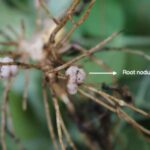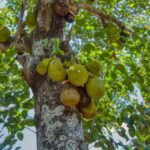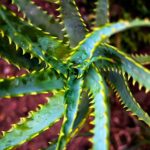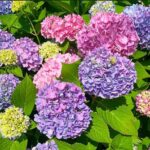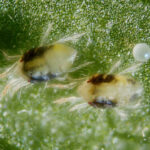Are you looking to add interest to your houseplant collection? Tradescantia “Nanouk” is the plant for you! This trendy plant is a brand new cultivar that was patented in 2017. Yes, this is a patented plant that has quickly gained popularity for its purplish-pink-streaked leaves and unusual growth habit. Tradescantia plants originated in South America, however, this cultivar developed in the Netherlands. (In fact, you can read the actual patent for the plant here.)
Tradescantia nanouk bears a striking resemblance to Tradescantia fluminensis – so much so that many major suppliers were selling T. fluminensis as Nanouk. But it’s not! Nanouk is a specific patented cultivar of Tradescantia albiflora. It’s also absolutely gorgeous in coloration and leaf shape, which sets it apart from other tradescantias. Tradescantia nanouk propagation is also amazingly simple for home use, and that can give you an endless supply of these plants once you get the parent plant established.
Quick Care Guide
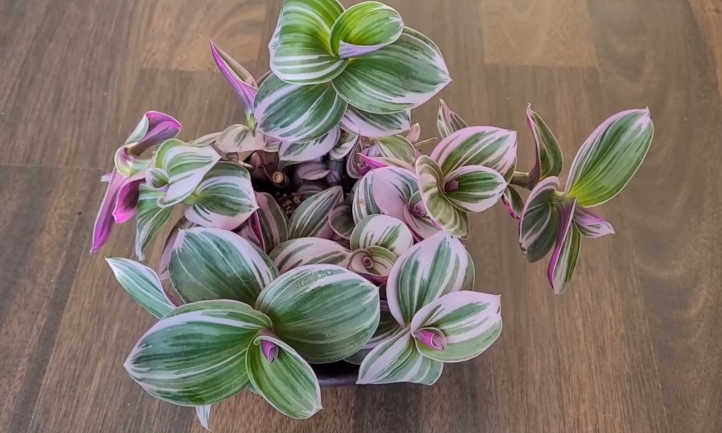
| Common Name | Fantasy Venice, Nanouk |
| Scientific Name | Tradescantia albiflora var. ‘Nanouk’ |
| Family | Tradescantia |
| Height & Spread | Indeterminate height and spread |
| Light | Indirect sunlight |
| Soil | Well-draining |
| Water | Moderate |
| Pests & Diseases | Spider mites, fungus gnats, fungal diseases, root rot |
All About Tradescantia Nanouk
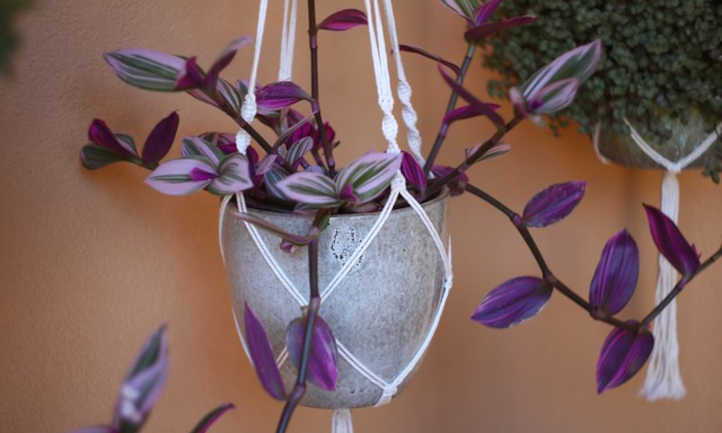
Tradescantia albiflora var. “Nanouk” has a few other common names such as Nanouk tradescantia, Fantasy Venice, Wandering Jew, Spiderwort, and Tradescantia bubblegum. Other forms of tradescantias originate from South America. As mentioned above, this variety was developed in the Netherlands and is described by its patent as “A new and distinct cultivar of Tradescantia plant named ‘Nanouk’, characterized by its compact and upright to broadly spreading plant habit; strong healthy leaves; light purple, green and greyed-green-colored leaves; and good interiorscape performance.”
Tradescantia fluminensis is very similar in appearance as it also has pink and green variegated foliage. However, Tradescantia nanouk is described as having a more vibrant color, thicker vines, and more vigorous growth. These plants are perennial and will put on growth year-round, although their main growing season and the time when they’re most vigorous is spring and summer. Tradescantia nanouk care is moderate as it requires specific growing conditions. Light pruning of dead and damaged foliage is recommended and though fertilizing is not necessary, if you’d like to give your plants a boost then it’s best to fertilize them in spring and summer.
Tradescantia Nanouk Care
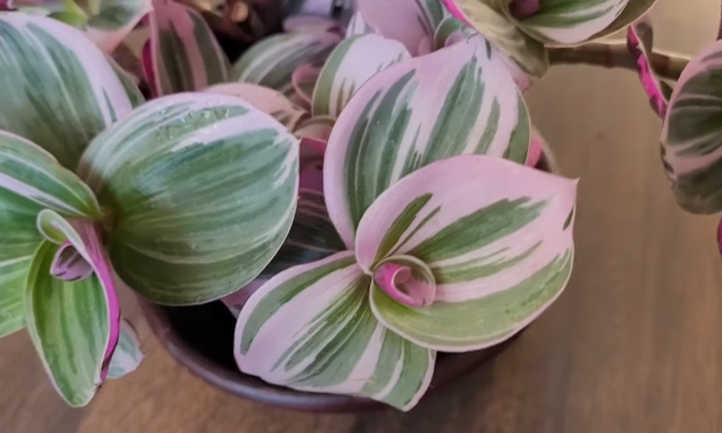
Tradescantia nanouk is a vigorous grower when provided with the right conditions. It is not necessarily a difficult plant to care for but does have a few requirements that need to be met for the best results. Read on to learn about keeping this trendy plant happy by providing it with enough light, well-draining soil, and houseplant fertilizer.
Sun and Temperature
Tradescantia nanouk do best in bright indirect sunlight. It can also thrive in full sun, though it may not flower as much, if at all. Tradescantia plants need 6-8 hours of bright indirect light per day for greater flower production. A sunny windowsill will meet these needs, as long as it has bright light. If the plants don’t receive enough light then the leaves will revert to solid green instead of the beautiful light purple/pink variegated foliage.
Tradescantia nanouk is winter hardy in USDA zones 10-12 and can be grown outdoors in these areas, though it is recommended to grow this plant as an indoor houseplant. It is much easier to maintain optimal growing conditions indoors that will reward you with pink and green foliage and pink buds that will burst into small white flowers. This plant is sensitive to both frost/freeze damage and extreme heat conditions. The ideal temperature range for this plant is between 55-75 degrees Fahrenheit which generally aligns with normal household temperatures.
Water and Humidity
Tradescantia nanouk require a moderate amount of water when planted in potting mix with good drainage. Make sure to provide your container with a drainage hole and a drip tray to catch any excess water. Determining the correct watering schedule will depend on your household environment and how quickly the soil dries. This plant has fairly shallow roots and therefore it is not recommended to bottom water this plant. A watering can with a skinny spout that can reach through the foliage down to the soil level works best. Water until at least the top inch of soil is saturated.
It is important to keep the soil moist, but avoid overwatering as this may cause issues with roots developing rot. Wait until the top 2 inches of soil is dry to avoid fungal infections. It is better to err on the side of underwatering rather than overwatering. This is another reason to grow this plant indoors in order to control the amount of water that it receives.
These houseplants prefer a humid environment and there are several ways to accomplish this if the environment inside of your home is dry. A pebble tray is a simple solution that can increase the humidity near your plant. Place a layer of small pebbles in a tray, fill the tray with water, and put the container with your nanouk on top. The water will slowly evaporate and create some humidity. Plant humidifiers are affordable and readily available to purchase online. You can also group houseplants together since the foliage releases moisture which will create humidity. A bulkier and less aesthetically pleasing option would be a humidity grow tent.
Soil

Tradescantia nanouk are very susceptible to root rot which means they will do best in well-draining soil. A standard houseplant mix with some coarse sand and/or orchid bark mixed in will do the trick. You can add a handful of perlite to increase the drainage in otherwise dense soil as well. This plant prefers slightly acidic soil in the ph range of 5-6, but it will also tolerate neutral soil. Slightly acidic soil will result in much more vibrant foliage. If you wish to acidify your soil, there will be instructions on the back of the package with a ratio of how much acidifier you will need to mix into the soil.
Fertilizing
Tradescantia nanouk care is relatively moderate, though it does not require fertilizer. It is a fast grower and does just fine without it. However, if you would like to give your plant a boost then a general all-purpose houseplant fertilizer diluted to half strength is a good option. Fertilizing with half the recommended strength once, or at most twice, a month will be more than enough to grow plants that are happy and healthy.
Pruning
Pruning is necessary for tradescantia nanouk if you’d like to promote compact growth. Conversely, hold back on pruning if you’d like the nanouk stems to grow tall and then fall over and trail down the sides of its container. At some point, you will need to prune back this plant to prevent your house from turning into a scene from Jumanji. This also gives an opportunity to propagate cuttings as well. In order to prune this plant make a cut just below a leaf node and then new growth will appear at the site. These plants are very forgiving to pruning since they grow so quickly so don’t be afraid of cutting it back for bushier growth.
Propagation
Since tradescantia nanouk is a patented plant, most of them come with a tag advising that propagation is not allowed. This applies to propagation that is intended for sale, and is not meant for home propagation – just don’t sell your young plants! Tradescantia nanouk is amazingly easy to propagate via cuttings. The plant parent will even send out aerial roots at the leaf nodes when it’s time for you to propagate plants.
To propagate tradescantia nanouk stem cuttings, place them in a glass of water and new roots will form within a week. Once measurable root growth appears then place them directly into the soil. The new plant will establish within a few weeks. You may even wish to place the cuttings into the same pot as the parent plant to help fill it out.
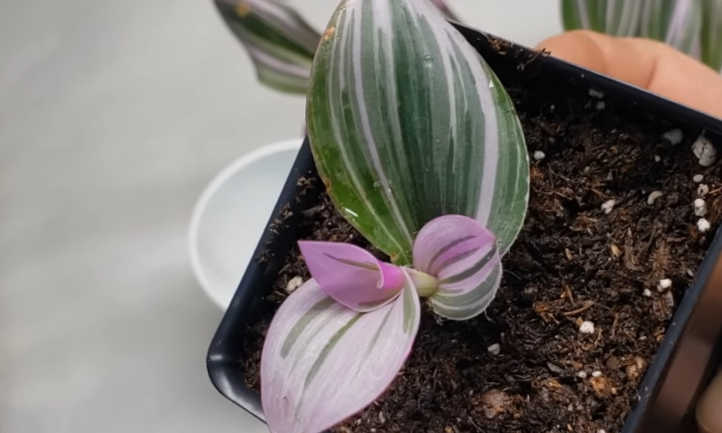
Troubleshooting
Tradescantia nanouk has quite a few requirements such as bright indirect light, a container with drainage holes, and evenly moist, well-drained soil. This is simple enough, but they are also susceptible to quite a few pests and diseases and there are some signs to watch for that can alert you to potential issues with your plants.
Growing Problems
Most houseplants are prone to overwatering and tradescantia nanouk is no exception. Container-grown plants can easily become waterlogged and essentially loved to death. Tradescantia nanouk is particularly susceptible to root rot when it is overwatered. If your plant is looking limp and the soil seems overly moist then cut back on watering until the top few inches of soil have completely dried out.
These are drought-tolerant plants that would rather be underwatered than overwatered. However, they can also suffer if they go without moisture for too long. Brown leaf tips indicate underwatering. They will recover quickly once they receive some moisture.
A common problem occurs when Tradescantia nanouk doesn’t receive enough direct light. If the leaves have lost their purplish-pink streaks and turned solid green, then this indicates that they need to be moved into an area with more light, ideally, full sun, to recover. Direct sunlight is the fastest way to bring the bright color of the foliage back and then the plants can be moved back into bright indirect light. At the same time, too much light during the hottest time of year can potentially cause leaf scorch, so try to limit the hot direct sun.
As with any container-grown plant you want to make sure that your tradescantia nanouk isn’t outgrowing its pot. If you pull the plant up by the base of the stems and notice the roots circling around the outside of the soil then it is likely that it needs to be transplanted into a bigger container. These plants a relatively shallow-rooted so it will take a while for the roots to get to this stage.
Pests
Spider mites are the most common issue for most indoor houseplants and nanouk tradescantia is no exception. They prefer a warm, dry environment with low humidity. A good preventative method to avoiding spider mites during tradescantia nanouk care is to keep the area around your houseplants humid. The first signs of mites will be tiny holes in the leaves or small yellowish spots on the foliage. You may even notice tiny web clusters on the leaves as well.
If spider mites have already appeared, but there is little to no damage to the plant then they can likely be manually removed with a forceful spray of water or wiping down your plants with a damp cloth. If the infestation is more serious, then insecticidal soap or organic insecticides containing pyrethrins can be effective at eliminating all the spider mites.
Overwatering your plants can create the perfect environment for fungus gnats. These gnats can cause damage to plants by feeding on their roots. Mature, established plants can usually withstand any damage from the gnats, but younger plants and seedlings are extremely susceptible. The gnats will appear at the soil level crawling around the base of the plants. A specific Bacillus thuringiensis variant found in the product Mosquito Bits is effective against these gnats.
Diseases
Overwatering causes most of the main problems for tradescantia nanouk and also contributes to the development of root rot, fungal diseases, and the previously-mentioned gnats.
Symptoms of fungal infections on tradescantia nanouk appear as brownish spots on the leaves. The leaves will wilt and eventually drop. To reverse the effects of fungal diseases, remove any damaged leaves, move the plant to an area with increased air circulation, and let the container dry out before watering again. In more serious cases an organic fungicide such as copper fungicide may be applied to the foliage.
The symptoms of root rot will appear as a soft mushy stem, wilting, and of course rotten roots. This type of rot is harder to recover from but can be remedied if there are still fresh, white roots that have not yet turned to mush. Cut back the rotted roots and replant the pot into dry soil.
Frequently Asked Questions
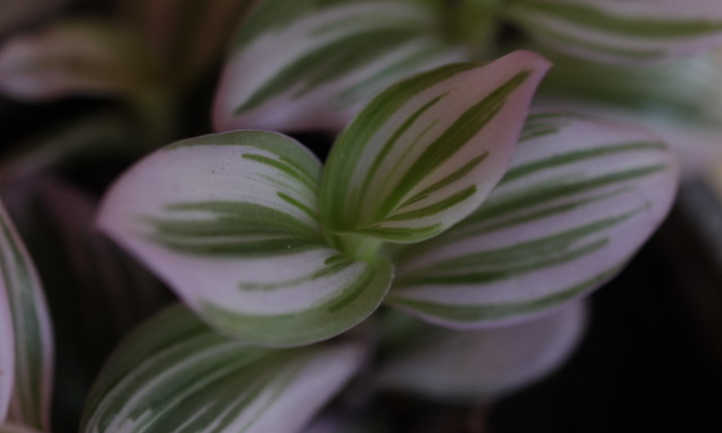
Q: Can I put my Tradescantia nanouk outside?
A: They can be placed outdoors when night temperatures remain above 55 degrees. Though it is recommended to grow them indoors to better control their growing conditions.
Q: Why is my Tradescantia nanouk turning green?
A: Low light will cause the leaves to turn green. Provide your plant with bright indirect sunlight to maintain the pink and green variegation.
Q: How do you propagate a nanouk?
A: By placing cuttings in water until roots develop.


